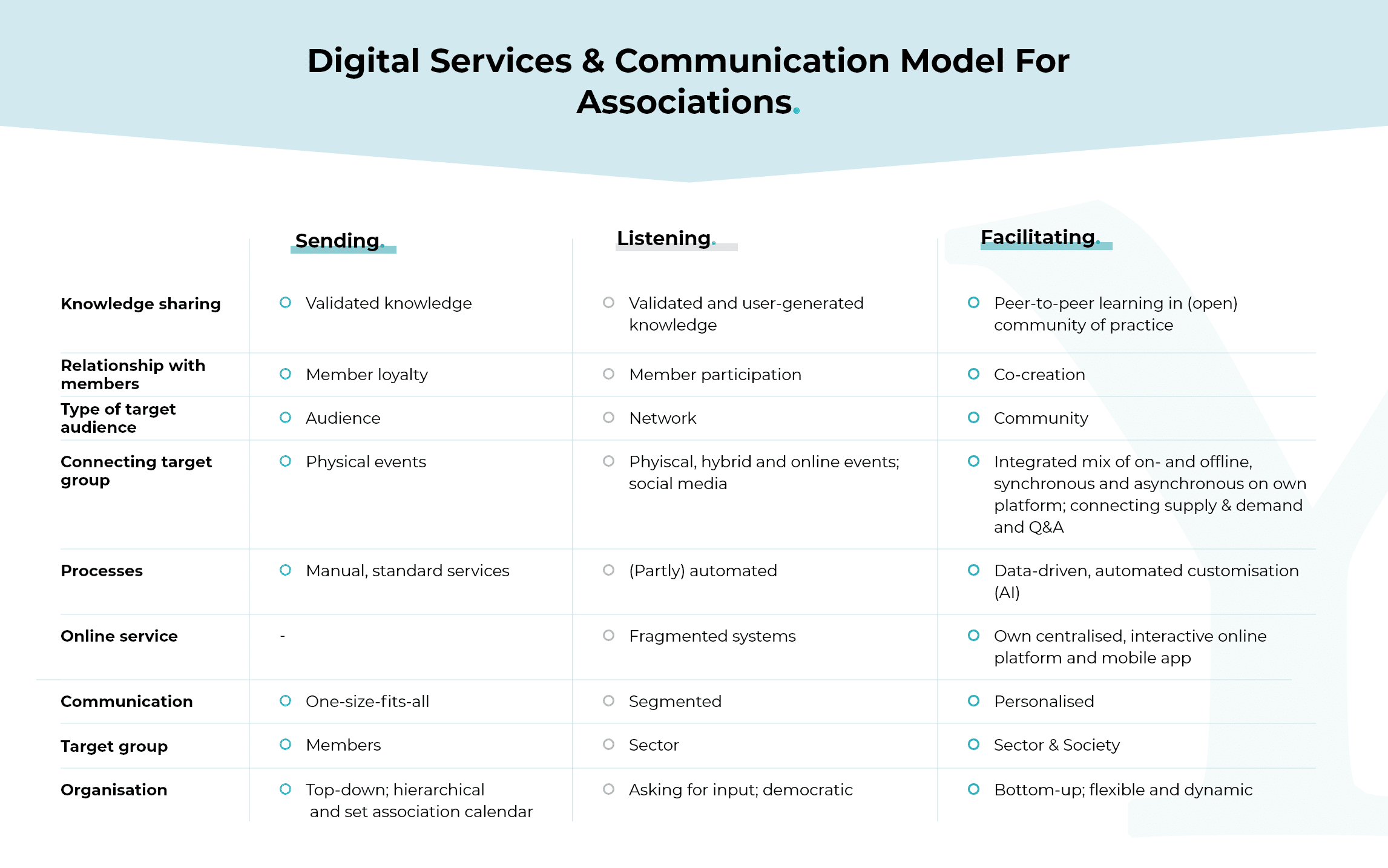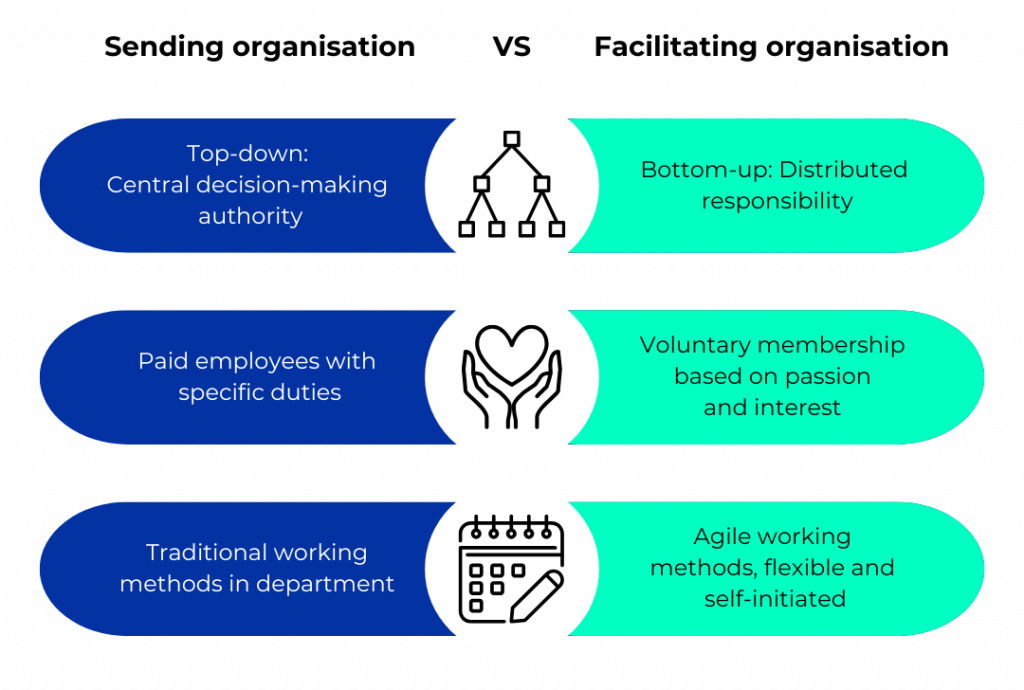Organisation and the changing role of associations [5/5]
The modern association focuses on facilitating members. This requires a different organisation of your association. So what should you think about? Mathijs and Dennis have taken you through the Digital Services & Communication Model for associations”. The model provides insight into where your association is digitally and where there is growth potential. In this last blog they provide tools and tips to work on a successful facilitating association at the organisational level.
By: Mathijs Vleeming & Dennis van Aalst, Yard | Digital Agency
Also read:
- Part 1 on the “Digital Service & Communication Model for Associations”.
- Part 2 on the value of knowledge sharing within an association.
- Part 3 on the (re)bonding of members
- Part 4 on how associations are setting up their digital services
(click on image to enlarge)

The facilitating association approaches the organization as a community This seems like something new, but it is not. Almost every association began as a community: a group of like-minded people working together toward a common goal based on shared needs and in shared responsibility. Yet we often see associations develop a sending, top-down organization the larger they get and the longer they exist. Members barely feel involved. So facilitating associations, with a community approach, basically goes back to the core. That means they must let go of top-down control and proactively challenge members to participate. That requires a culture change.

Organisation: from top-down to bottom-up
The sending association is organized hierarchically. “Foremen and women” on boards determine the association’s agenda. Communication is almost exclusively one-way. For example, via letters, e-mails or events with lectures without further interaction.
Listening associations are somewhat less traditional. These associations ask their members for input. For example, through surveys and democratic decision-making. However, the agenda is still set by the organization’s leaders.
The modern association is an enabling association. It is bottom-up by definition: members set the agenda directly. This goes beyond asking members for input. The association also uses data to understand their members and works closely with them. Members are challenged to participate proactively and they are given responsibility.
Cross-industry collaborations
Facilitating associations at the forefront do not focus only on their own association. Rather, they are also engaged with their industry and adjacent industries. Because major issues at associations today are no longer one-dimensional, but touch several disciplines. Disciplines that often lie beyond the boundaries of the association.
Associations with a future vision, implement a truly member-centric approach, for example by entering into coalitions with other associations. They set up innovation hubs and provide public online platforms for knowledge sharing and connection with other industries. As a result, innovation really takes off.
Different membership models
In cross-industry collaboration, having your own online platform allows you to work with different membership models. For example, make general knowledge publicly available via your website, and in-depth knowledge or dossiers are offered via a login environment for members.
Case TVVL: members and non-members find each other
A great example of an association leading the way is TVVL, together with Techniek Nederland, Bouwcampus or Bouwend Nederland. On their online platform KUBR, members and non-members strengthen each other. Anyone working in engineering and construction can sign up for KUBR. Participants do not have to be members of TVVL, Techniek Nederland, Bouwcampus or Bouwend Nederland. This way, members and non-members reinforce each other. They can connect with each other through themes or groups, and exchange knowledge and share publications.
Read more about online community platform KUBR.
Case Nevi: members and non-members lift procurement profession to higher level
Inside Procurement is the knowledge network for procurement, contract and supply management. Professionals and experts connect and meet in the community. Together they share knowledge, expertise, best practices and other valuable information. Inside Procurement was launched by Nevi, the association focused on the procurement profession.
Inside Procurement not only targets Nevi members, but also non-members. Nevi’s mission is to take the procurement profession to the next level. For the individual, for organizations and for society. That’s why Inside Procurement is a public community, with the exception of a few closed groups. Anyone working in or interested in the procurement profession can join Inside Procurement.
Read more in the case about Nevi.
Tips for a successful community
Suppose you want to develop your association toward the facilitating association, how do you go about it? we give you 2 tips.
Tip 1: Experiment and accept margin for error
What works depends a lot on what type of association you are and what kind of members you have. Therefore, experiment with other forms of organization. Then you will discover where the value lies for your association. The board and other association leadership must give you room to try things out. That space should also be provided within the organization’s resources. For example, like the KNVB, hire an agile coach to supervise experimentation.
You often see that if there is room to experiment, employees of such an association become very enthusiastic and join in. Then the experiment can grow into something beautiful.
Keep in mind that experiments can also fail. That’s how innovation works, and it doesn’t matter. You learn from it.
That sometimes makes it scary for an association: you invest in a certain direction, involve your members and you don’t know yet what the results will be. Still, it is good to include those experiments in your association DNA, so that you also dare to take new paths as an association. Sometimes they are dead ends, but sometimes they grow into highways.
Tip 2: do it together!
The second tip is the most important: do it together! Start building your online community together with yourmost active members and ensure organic growth. Facilitate and amplify the existing sense of belonging within your association and jointly find a suitable solution that live up to existing member needs. Recruit around 10 ambassadors for your online community among your members and start small and simple. Then grow together in co-creation.
Read previous blogs in this blog series here:
Want more tips? Watch the webinar 7 tips for a successful community
About the Authors
Mathijs believes that associations can increase their impact by connecting their members throughout the year and facilitating knowledge sharing. He draws on his 20 years of experience in the “heart of the world of professional community builders,” specifically in the international meetings industry for association conferences and events at the International Congress and Convention Association, where he was Director of Marketing.
For over 3 years, Mathijs has worked as a community strategist and consultant. In this role, he helps associations and other organizations create online community strategies. He does this at Yard Digital Agency, the market leader in digital communication and community solutions for associations and public organizations in the Netherlands.
Mathijs wrote an eBook with input from associations and community leaders titled “The Association Community Compendium: How to Harness the Collective Power of Your Members.” He is also a board member of the Community Consultants Collective and a contributing expert for Association Meetings International.


Dennis believes in the power of digital. With passion, he and his motivated colleagues support social organizations in achieving digital impact. Dennis is an experienced online strategist within the association sector. [Can you provide evidence of this and share more about your experience with associations?] Due to his in-depth knowledge of associations, he serves as a sparring partner and advisor for associations looking to grow digitally.
Together with the KNVB and Yard | Digital Agency, Dennis won the Dutch Interactive Award (DIA) 2021 in the category of communities. They won this award for the platform Eén tweetje, for which Dennis developed the strategy in collaboration with the KNVB [is this correct?]. “The community represents a game changer in the way the KNVB communicates,” according to the jury. “A shift from top-down to peer-to-peer.”
Additionally, Dennis is a trainer in digital communities at De Nederlandse Associatie (DNA). Through open and in-company workshops, he helps industry and professional associations discover the value of an online community. He also guides them in launching an online community and fostering interaction and engagement within the community.

Watch: Case Study TVVL
TVVL is the largest association of professionals in installation technology. How does this association use digital possibilities to connect its members and exchange knowledge? John Lens, Director of TVVL, talks about it with Mathijs Vleeming and Dennis van Aalst.
Also read

Enhance your events and community with the Yunits Conference Module

7 Main Challenges for Associations

